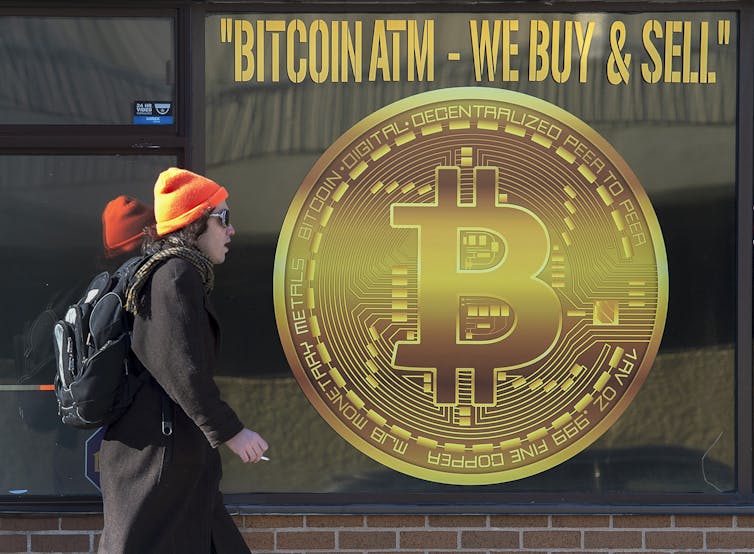In 2008, someone using the pseudonym Satoshi Nakamoto published the design of the cryptocurrency bitcoin, proposed the initial code and was active online for just under two years. In this time, they helped develop the code, answer questions and promote the project. Then, claiming to busy with new things, Nakamoto left working on bitcoin and was probably never heard from again.
HBO’s 2024 documentary Money Electric: The Bitcoin Mystery finds director Cullen Hoback looking for the real Nakamoto, motivated by bitcoin being “embraced by nation states” and “incorporated into 401(k)s.”
Read more:
Bitcoin turns ten – here’s how it all started and what the future might hold
The real Nakamoto?
Several attempts to unmask Nakamoto have been made before. Previous theories suggest that the elusive developer is Irish graduate student Michael Clear, Japanese-American systems engineer Dorian Nakamoto or one of several cypherpunks who worked on predecessors to bitcoin: Hal Finney, Nick Szabo or Adam Back.
Hoback confronts the man he suspects of being Nakamoto on camera in the film’s climax: Peter Todd, a software developer from Toronto. On film, Todd alternates between joking about being Nakamoto and calling the theory ludicrous, perhaps necessitating him to make an unequivocal denial in the press after it aired.
The documentary is entertaining, but does it play it fast and loose? I would draw attention to three things that deserve further thought.
Online breadcrumb trail
While stopping short of claiming to have conclusively identified bitcoin’s creator, Hoback suggests something Todd once said to Nakamoto online was a slip up.
The background is this: with bitcoin, users leave tips to have their transactions processed. If the tip is too low, the computers running bitcoin will refuse to process it and the transaction will sit in bitcoin purgatory. Worse, bitcoin users who make this mistake cannot increase the fee without it looking like an attack on the system.
In an online post, Nakamoto posts that transactions could be declared safe if they only changed the amount of the fee.
Not long after, Todd chimes in that this is impossible with how bitcoin transactions work. The increased fee has to come from somewhere, namely a decrease in the amount paid out, which changes the transaction. Todd’s message is short: “Of course, to be specific, the inputs and outputs can’t match *exactly* if the second transaction has a transaction fee.”
Hoback ponders if maybe Nakamoto meant to correct himself, but somehow accidentally used his real account.
As the documentary recounts, Todd is smart, has developer experience and had been discussing digital cash online since he was a teenager. Todd would eventually be the one to implement the feature Nakamoto described, albeit with a fix to the issue he pointed out.
The theory plays out well on film but leaves out a few considerations.
Early bitcoin enthusiasts were a self-selecting group, and most were as technically minded as Nakamoto or Todd. This technical background is niche but not rare: more than 100,000 computer science students graduate annually in the United States, while there are over 500,000 certified security experts. And there are many equally capable people who are neither of these things.
Given Hoback’s evidence for Todd is circumstantial, the weight shifts to Todd’s reaction on camera when Hoback outlines his theory: a mix of bemusement, mockery and indignation. The film frames the reaction as incriminating, while others caution against reading anything into it.
Enter Ethereum
Bitcoin is maintained by an open group of volunteered computers (whose operators are paid in new bitcoin for the work of validating transactions and storing them on a ledger called the blockchain) where no one is in charge, and yet maintains high security.
Early bitcoin enthusiasts saw the potential for bitcoin’s blockchain technology to handle more than financial transactions, but the developers helming bitcoin (including Todd) thought it would be best if bitcoin stayed in its lane.
Some bitcoin enthusiasts in Toronto then banded together and launched Ethereum. Led by 21-year-old Vitalik Buterin, Ethereum provides a platform where anyone can run their code on a blockchain simply by paying a fee and pushing a button. The code could be anything from a new digital currency to sophisticated financial technology.
In Hoback’s documentary, many of the interviewees view bitcoin and its developers as competitors and antagonists of Ethereum.
Ethereum gets only about two minutes of screentime, dominated by Buterin rapping about Ethereum on the mainstage of a conference and being ribbed for his hat’s safari flaps.
Hoback’s documentary emphasizes Ethereum’s scam tokens but overlooks the innovative financial services that captured US$64 billion of assets in 2021, as well as its advancements in areas like efficiency and cryptography.
Ironically, it is Ethereum technology that runs crypto-betting platform Polymarket, which hosted a US$44 million betting pool on who would be named as Nakamoto in Hoback’s film before it aired.
“Polymarket turned Money Electric into a sporting event,” Hoback enthused. “Even I’m refreshing the betting pool to see how high the total volume gets.”

THE CANADIAN PRESS/Andrew Vaughan
The end of privacy?
In his 2014 documentary, Terms and Conditions May Apply, Hoback did show he is willing to tackle social concerns that might seem a little dry or academic, such as privacy rights in a digital age.
He picks up this thread again in Money Electric, embedding an earnest message about the potential privacy and surveillance implications of governments — including Canada, the United States and 130 other countries — launching central bank digital currencies (CBDCs), something my research also draws attention to.
In theory, the technology underlying bitcoin can be expanded to provide a CBDC system as private as paper cash. However it will take a strong political will to get there.
